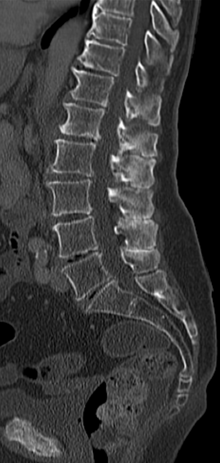Baastrup's disease
| Classification according to ICD-10 | |
|---|---|
| M48.2- | Baastrup syndrome |
| ICD-10 online (WHO version 2019) | |
Baastrup's sign , according to Christian Ingerslev Baastrup also Baastrup syndrome or Baastrup character called, is a term for back pain due to the juxtaposition of spinous processes ( spinous process ) and irritation of the surrounding soft tissues (ligaments and muscles). In the English-speaking world, the disease is therefore appropriately called " kissing spine disease ".
causes
The cause of this approach is usually the general degeneration of the spine and the associated loss of height. However, an enlargement ( hypertrophy ) of the spinous processes due to vigorous physical work is also discussed ( causal histogenesis ). Typical activity that may cause such hypertrophy can be long-term shoveling activity (e.g. in road construction).
clinic
During the examination, the patient reports pressure and tapping pain over the spinous processes and the surrounding soft tissues. In the stretch ( extension ) of the spine, a reinforcement of the pain symptoms shows.
diagnosis
- Radiologically : Radiologically proven contact of spinous processes , mainly in the lumbar spine area as a result of increased lordosis and mostly wear- related narrowing of the intervertebral discs with the formation of reactive sclerosis and nearthrosis . Functional recordings in reclination may show direct contact with the affected spinous processes .
- Infiltration diagnosis : Infiltration with local anesthetic in the area of the painful spinous processes removes the pain and thus ensures the diagnosis.
therapy
Conservative therapeutic approaches :
- Physiotherapy, heat application, electrotherapy, infiltration with anti-inflammatories and local anesthetics, etc.
Operative therapeutic approaches :
- Elimination of the cause, i.e. reduction in size of the spinous processes. However, since additional signs of wear and tear of the spine often occur, residual symptoms are not uncommon.
See also
- Kissing spine on the horse
- arthrosis
literature
- Chr. I. Baastrup: On the Spinous Processes of the Lumbar Vertebrae and the Soft Tissues Between them and on Pathological Changes in that Region. In: Acta Radiologica. 1933.
- D. Resnick: Degenerative diseases of the vertebral column. In: Radiology. 1985 Jul; 156 (1), pp. 3-14. PMID 3923556
